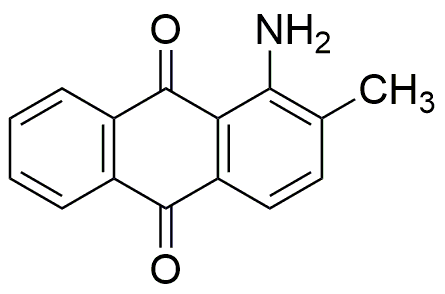1-Amino-2-methylanthraquinone is widely utilized in research focused on:
- Dyes and Pigments: This compound is commonly used in the production of dyes for textiles and paper, offering vibrant colors and excellent lightfastness, making it ideal for industries that require durable colorants.
- Photovoltaic Applications: Its properties make it suitable for organic solar cells, where it can enhance light absorption and improve energy conversion efficiency, contributing to the development of sustainable energy solutions.
- Analytical Chemistry: The compound serves as a reagent in various analytical techniques, including spectrophotometry, helping researchers detect and quantify substances with high precision.
- Pharmaceuticals: It is explored for its potential in drug development, particularly in creating compounds that target specific biological pathways, which can lead to innovative treatments.
- Environmental Applications: The chemical is being investigated for its role in environmental remediation processes, such as the degradation of pollutants, showcasing its potential in addressing environmental challenges.
General Information
Properties
Safety and Regulations
Applications
1-Amino-2-methylanthraquinone is widely utilized in research focused on:
- Dyes and Pigments: This compound is commonly used in the production of dyes for textiles and paper, offering vibrant colors and excellent lightfastness, making it ideal for industries that require durable colorants.
- Photovoltaic Applications: Its properties make it suitable for organic solar cells, where it can enhance light absorption and improve energy conversion efficiency, contributing to the development of sustainable energy solutions.
- Analytical Chemistry: The compound serves as a reagent in various analytical techniques, including spectrophotometry, helping researchers detect and quantify substances with high precision.
- Pharmaceuticals: It is explored for its potential in drug development, particularly in creating compounds that target specific biological pathways, which can lead to innovative treatments.
- Environmental Applications: The chemical is being investigated for its role in environmental remediation processes, such as the degradation of pollutants, showcasing its potential in addressing environmental challenges.
Documents
Safety Data Sheets (SDS)
The SDS provides comprehensive safety information on handling, storage, and disposal of the product.
Product Specification (PS)
The PS provides a comprehensive breakdown of the product’s properties, including chemical composition, physical state, purity, and storage requirements. It also details acceptable quality ranges and the product's intended applications.
Certificates of Analysis (COA)
Search for Certificates of Analysis (COA) by entering the products Lot Number. Lot and Batch Numbers can be found on a product’s label following the words ‘Lot’ or ‘Batch’.
Numéro de catalogue
Numéro de lot/série
Certificates Of Origin (COO)
This COO confirms the country where the product was manufactured, and also details the materials and components used in it and whether it is derived from natural, synthetic, or other specific sources. This certificate may be required for customs, trade, and regulatory compliance.
Numéro de catalogue
Numéro de lot/série
Safety Data Sheets (SDS)
The SDS provides comprehensive safety information on handling, storage, and disposal of the product.
DownloadProduct Specification (PS)
The PS provides a comprehensive breakdown of the product’s properties, including chemical composition, physical state, purity, and storage requirements. It also details acceptable quality ranges and the product's intended applications.
DownloadCertificates of Analysis (COA)
Search for Certificates of Analysis (COA) by entering the products Lot Number. Lot and Batch Numbers can be found on a product’s label following the words ‘Lot’ or ‘Batch’.
Numéro de catalogue
Numéro de lot/série
Certificates Of Origin (COO)
This COO confirms the country where the product was manufactured, and also details the materials and components used in it and whether it is derived from natural, synthetic, or other specific sources. This certificate may be required for customs, trade, and regulatory compliance.


